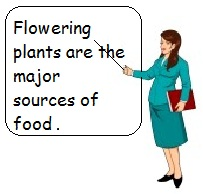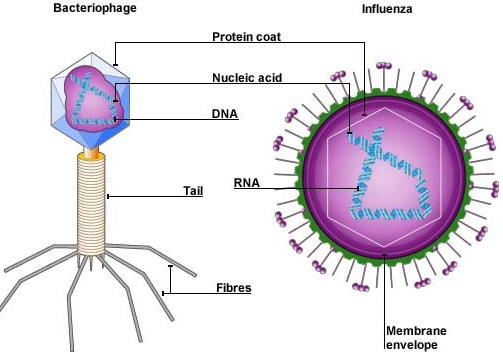Kingdom Plantae and Animalia
Table of Content |
Kingdom Plantae
 Kingdom plantae includes green, brown and red algae, liwerworts, mosses, ferns and seed plants with or without flowers. They have the following characters.
Kingdom plantae includes green, brown and red algae, liwerworts, mosses, ferns and seed plants with or without flowers. They have the following characters.
(1) Multicellular organisms with walled and frequently vacuolate eukaryotic cells.
(2) They contain photosynthetic pigment in plastids.
(3) Principal mode of nutrition is photosynthesis but number of plants have become absorptive.
(4) Primarily non-motile, living anchored to a substrate.
(5) Structural differentiation leading towards organs of photosynthesis, anchorage and support and in higher forms towards specialised photosynthetic, vascular and covering tissues.
(6) Reproduction is primarily asexual or sexual. The reproductive organs are multicellular.
(7) A multicellular embryo is formed during development from the zygote. Algae lack embryo stage. Life cycle consists of alternating haploid gametophyte and diploid sporophyte generation. This phenomenon is called alternation of generation.
Watch this Video for more reference
Classification of Plantae
August Wilhelm Eichler (1883) a Vinnese botanist, divided plant kingdom into two sub-kingdoms mainly on the basis of presence or absence of seeds.
(1) Cryptogamae (Gr. Cryptos = hidden; gamos = marriage): Lower plants in which sex organs are hidden and seeds and flowers absent. It includes Thallophytes, Bryophytes, pteridophytes.
(2) Phanerogamae (Gr. Phaneros = visible; gamos = marriage): Higher plants in which sex organs are evident; seeds present. It includes Gymnosperms and Angiosperms.

Thallophyta
-
Comprises the simplest plants which possess undifferentiated or thallus like forms.
-
Reproductive organs single celled no jacketed called gametangia.
-
Embryo stage, vascular and mechanical tissues are all absent.
-
Differentiation of true roots, stems and leaves is also absent.
-
Asexual reproduction by accessory spores is very common. Presently, it includes only Algae.

Bryophytes
These are nonvascular terrestrial plants of moist habitats in which a multicellular diploid sporophyte lives as a parasite on an independent multicellular haploid gametophyte that develops multicellular jacketed sex organs.
Vascular plants – tracheophyta
-
They are those plants which posses conductiong or vascular tissues, xylem and phloem. Xylem transports water and minerals while phloem conducts organic food.
-
Vascular plants comprise more than 275,000 living species.
-
They are most visible green plants around us, so much so that the term ‘plants’ generally means vascular plants.
Pteridophytes- pteridophyta
Pteridophytes are seedless vascular or bryptogamic plants that have sporophytic plant body, inconspicuous gametophytes contining small sessile antheridia and partially embedded archegonia with 4- rowed neck.
-
They comprise over 250,000 vascular plants.
-
After sexual reproduction,the plants produce seeds for dispersal and multiplication. The seeds are dormant and can easily pass through unfavourable conditions.
-
The plant body belongs to sporophytic generation.
-
The sporophytic plant body is differentiated into true stem, lves and roots.
-
Plants show heterospory or two types of meiospores, microspores and megaspores.

Gymnosperms
Gymnosperms are those seed plants in which the seeds remain exposed over the surface of the megasporophylls because the latter are not folded to form pistils.
Angiosperms
Angiosperms are those seed plants in which seeds are formed inside fruits and the sporophylls are organized into flowers.
|
|
Kingdom Animalia
 - This kingdom is characterised by heterotrophic eukaryotic organisms that are multicellular and their cells lack cell walls.
- This kingdom is characterised by heterotrophic eukaryotic organisms that are multicellular and their cells lack cell walls.
- They directly or indirectly depend on plants for food. They digest their food in an internal cavity and store food reserves as glycogen or fat.
- Their mode of nutrition is holozoic - by ingestion of food.
- They follow a definite growth pattern and grow into adults that have a definite shape and size.
- Higher forms show elaborate sensory and neuromotor mechanism.
- The sexual reproduction is by copulation of male and female followed by embryological development.
-
Anaima: Animals without red blood e.g., sponges, cnidaria, mollusca, arthropoda, echinodermata, etc.
-
Vivipara: Animals which give birth to young ones are included in this subgroup e.g., man, dogs, cows, etc.
-
Ovipara: Animals which lay eggs are included in this subgroup e.g., frogs, toads, lizards, snakes, birds, etc.
-
Anamniotes: Vertebrates without embryonic membranes e.g., fishes, amphibians.
-
Amniotes: Vertebrates with embryonic membranes (chorion, amnion, allantois, yolk sac) e.g., reptiles, birds, mammals.
-
Acraniata or Protochordata: Chordates without cranium (brain box). It includes urochordata and cephalochordata.
-
Chordates: Animals with notochord dorsal tubular nerve cord, paired pharyngeal gill slits.
-
All urochordates, cephalochordates and vertebrates are called chordates.

-
Craniata or Vertebrate: Chordates with cranium.
-
It Includes cyclostomes, pisces, amphibians, reptiles, birds and mammals.
-
Nonchordates: Animals without notochord (a rod like elastic structure which supports the body). Phylum Porifera to phylum Hemichordata are called nonchordates.
-
Invertebrates: Animals without vertebral coloumn (backbone). All the nonchordates, urochordates and cephalochordates are callectively called invertebrates.
Watch this Video for more reference
Viruses, Viroids and Lichens
-
The viruses are non-cellular organisms that are characterised by having an inert crystalline structure outside the living cell. Once they infect a cell they take over the machinery of the host cell to replicate themselves, killing the host.
-
The name virus that means venom or poisonous fluid was given by Pasteur. D.J. Ivanowsky (1892) recognised certain microbes as causal organism of the mosaic disease of tobacco. These were found to be smaller than bacteria because they passed through bacteria-proof filters.
-
M.W. Beijerinek (1898) demonstrated that the extract of the infected plants of tobacco could cause infection in healthy plants and called the fluid as Contagium vivum fluidum (infectious living fluid).
-
W.M. Stanley (1935) showed that viruses could be crystallised and crystals consist largely of proteins. They are inert outside their specific host cell.
-
Viruses are obligate parasites.
-
In addition to proteins viruses also contain genetic material, that could be either RNA or DNA.
-
No virus contains both RNA and DNA.
-
A virus is a nucleoprotein and the genetic material is infectious. In general, viruses 'that infect plants have single stranded RNA and viruses that infect animals have either single or double stranded RNA or double stranded DNA. Bacterial viruses or bacteriophages (viruses that infect the bacteria) are usually double stranded DNA viruses.
-
The protein coat called capsid made of small subunits called capsomeres, protects the nucleic acid. These capsomeres are arranged in helical or polyhedral geometric forms.
-
Viruses cause diseases like mumps, small pox, herpes and influenza. AIDS in humans is also caused by a virus. In plants, the symptoms can be mosaic formation, leaf rolling and curling, yellowing and vein clearing, dwarfing and stunted growth.

-
Viroids: In 1971 T.O. Diener discovered a new infectious agent that was smaller than viruses and caused potato spindle tuber disease. It was found to be a free RNA; it lacked the protein coat that is found in viruses, hence the name viroid. The RNA of the viroid 'was of low molecular weight.
-
Lichens: Lichens are symbiotic associations i.e, mutually useful associations, between algae and fungi. The algal component is known as phycobiont and fungal component as mycobiont, which are autotrophic and heterotrophic, respectively.
-
Algae prepare food for fungi and fungi provide shelter and absorb mineral nutrients and water for its partner.
-
Lichens are very good pollution indicators - they do not grow in polluted areas.


Question1: Which animal is ‘‘Non-chordate-protochordata’’
(a) Herdamania
(b) Balanoglossus
(c) Branchiostoma
(d) Botryllus
Question2: Sometimes parasites themselves are parasitised by other organism, such parasites known as
(a) Symbionts
(b) Endoparasites
(c) Ectoparasites
(d) Hyperparasites
Question3: On the basis of body organization, animals are grouped as
(a) Metazoa and eumetazoa
(b) Protozoa and parazoa
(c) Parazoa and metazoa
(d) Protozoa and metazoan
Question4: Among the following organisms point out a completely non-parasitic form
(a) Sea anemone
(b) Leech
(c) Tape worm
(d) Mosquito
Question5: A common characteristic of all vertebrates without exception is
(a) The possession of two pairs of functional appendage
(b) The presence of well-developed skull
(c) The division of body into head, neck, trunk and tail
(d) Their body is covered with an exoskeleton
![]()

| Q.1 | Q.2 | Q.3 | Q.4 | Q.5 |
| b | d | d | a | b |
Related Resources
-
Click here to refer the Useful Books of Biology for NEET (AIPMT)
-
Click here for Study Material on Kingdom Protista
To read more, Buy study materials of Biological Classification comprising study notes, revision notes, video lectures, previous year solved questions etc. Also browse for more study materials on Biology here.
View courses by askIITians


Design classes One-on-One in your own way with Top IITians/Medical Professionals
Click Here Know More

Complete Self Study Package designed by Industry Leading Experts
Click Here Know More

Live 1-1 coding classes to unleash the Creator in your Child
Click Here Know More






